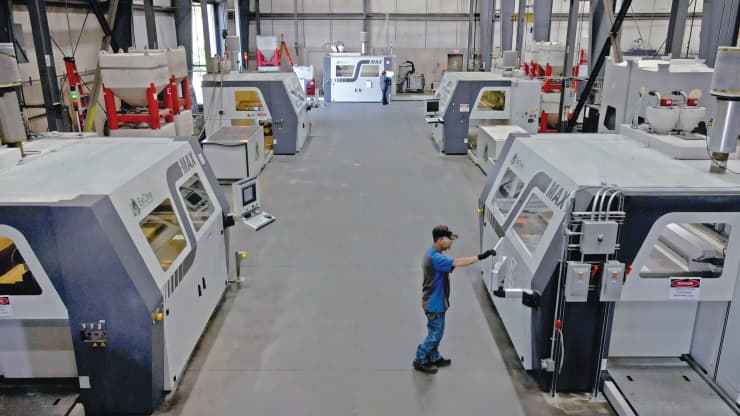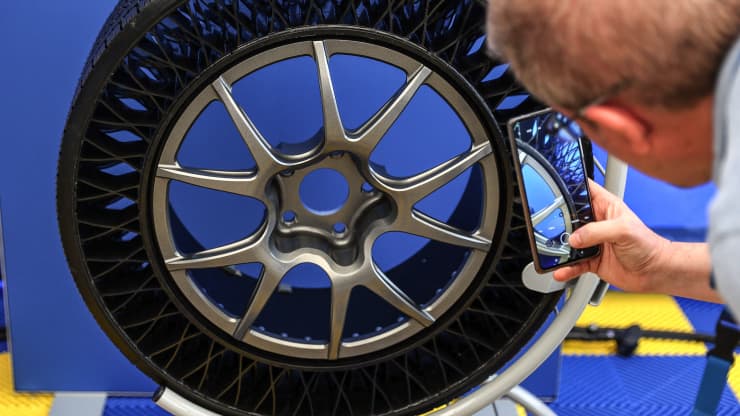Additive manufacturing is on the cusp of being adopted more widely by industry, as large corporates Goodyear Tire & Rubber Company and Boeing as well as small innovative start-ups prove it can work well at scale in manufacturing.
Highlights
- Goodyear opened a $77 million plant in Europe that uses 3-D printing in its tire manufacturing and recently tested new 3-D printed airless tires on a Tesla.
- The use of 3-D printers by industrials, also known as additive manufacturing, has been rising and includes Boeing, GE, Caterpillar and Cummins.
- But it’s still a relatively small part of manufacturing, just 2-3% of the $12 trillion production market, according to a McKinsey estimate, though it is expected to grow rapidly over the next decade.
In May, Goodyear opened a $77 million plant in Luxembourg that centers on 3-D printing and can make tires four times faster in small batches than with conventional production. Goodyear also is testing its new 3-D printed airless tire technology on Tesla electric vehicles and Starship Technologies’ autonomous delivery robots. It has been working for the past several years on improved manufacturing techniques at an R&D center near Columbus, Ohio.
By 2030, Goodyear aims to bring maintenance-free and airless tires to market, and 3-D printing is part of that effort for the Akron-based tire-making leader founded in 1898 and named after innovator Charles Goodyear. Currently, about 2% of its production is through additive manufacturing and more integration into the mix is in sight.
“Like with any innovation, targeting the right use case is key. 3-D printing is not for every job. We’re using additive manufacturing for higher-end, ultra-high performance tires that require much more complexity, and in smaller lot sizes,” said Chris Helsel, senior vice president, global operations and CTO at Goodyear. “There is still a benefit of making large runs of tires efficiently through a normal assembly line.”
Leveraging the new technology takes patience. “You can’t bring it in, turn it on. It is not a short journey. We have been on this route for 10-12 years,” Helsel said. In an initial commercialization of its 3-D printed airless tires in 2017, Goodyear started equipping premium lawnmower models made by Bad Boy Mowers.
Recent history and future growth of 3-D printing
The technology of printing objects layer by layer from computerized designs traces back to the early 1980s. Now it’s transforming factories and is no longer considered a novelty, though it was popularized over a decade ago by desktop 3-D printing firm MakerBot in the consumer hobbyist market. Today, a range of products from airplane parts to teeth aligners and car seats are being made additively.
This newish technology is being eyed as a competitive advantage, and a way of enhancing the U.S. manufacturing base and supply chain. But it may not revolutionize industrial production overall.
“Additive manufacturing is still a very small, specialized technology,” said Jörg Bromberger, director of strategy and operations at McKinsey in Berlin, and lead author of the consulting firm’s recent report on the industrial technology. “Heavily investing in additive manufacturing can bring some effect but it is still pretty limited,” he said.
Primarily useful for making specialized high-value parts and smaller production volumes, Bromberger pegged additive manufacturing at 2-3% of the $12 trillion production market.
3-D printing industry consultant Wohlers Associates expects additive manufacturing to grow at a relatively strong pace and predicts the market worldwide will reach $85.3 billion in 2031 from $15.2 billion in 2021. The leading industrial sector using the technology is aerospace, followed by medical/dental and automotive, while the most common applications for 3-D printing are for making end-use parts and functional prototypes, according to the firm’s Wohlers Report 2022.
The main advantages of the technology include design flexibility in various 3-D shapes that can perform better or cost less, and customized production of parts. Other advantages are cutting out time-consuming, pre-production processes and making products on-demand from digital files.
A chief barrier to adoption is investment costs. Prices for industrial 3-D printing machines can vary from $25,000 to $500,000 and up to $1 million for huge systems. Further limitations are a lack of engineering talent to implement the technology, a knowledge gap among businesses about why and how to use it, cultural resistance on the shop floor to change, and too few end-to-end 3-D printing systems.
Consolidation of suppliers underway in the industrial market could provide more full service and one-stop purchasing for manufacturers. For instance, Burlington, Mass.-based Desktop Metal acquired The ExOne Company in North Huntingdon, Pa. in a November 2021 deal that brought multiple additive manufacturing solutions under one roof.
But stock market reception of 3-D printing as a pure-play investment theme has not been good in recent years. Desktop Metal has lost almost 80% of its value since going public in 2021, and the performance of other 3-D printing sector plays has been poor even as the technology advances.
In another notable partnership, some of the nation’s largest industrials are working with a family-owned Rust Belt firm to 3-D print components.
Humtown Products, a 63-year-old, family-owned foundry near Youngstown, Ohio, adopted 3-D printing in 2014 as an efficient way to make industrial cores and molds. Its early adoption helped the company stay in business after struggling through the 2009 recession and as the U.S. foundry business moved offshore or died out in the face of cheaper overseas competition. Humtown Products was able to retain large corporate customers including GE, Caterpillar and Cummins.
Today, its additive manufacturing division accounts for 55% of overall revenue and is growing by 50% annually. Pivoting to 3-D printing was the company’s “Kodak moment,” said owner and president Mark Lamoncha. “If you are not in the next space, you are out of business,” Lamoncha said. “This industry is at a tipping point to commercialization and in many disciplines it is the equivalent of driving a race car,” he said.
Truck engine builder Cummins is using Humtown as a supplier that can improve its accuracy in making 3-D printed castings, and has streamlined production by printing large parts in a single piece rather than composites. “We’ve had good success with it. The volumes are starting to ramp up, and while the prices are still a bit higher than conventional processes, it is a lot more accurate, and we’ve able to triple our process capability, or output,” said Cummins technical advisor Larry Lee.

Humtown Products
Humtown Products was able to tap into the technology through a cluster of 3-D printing resources in Youngstown that business, government and academia have supported to help revive the local economy of the former steel town. This tech hub encompasses several entities that position northeast Ohio at the forefront of the 3-D printing industrial revolution: government-supported industry accelerator America Makes, the Youngstown Business Incubator that houses 12 additive startups, such as industrial machine builder and designer JuggerBot3d, and Youngstown State University’s Center for Innovation in Additive Manufacturing and new $12 million Excellence Training Center.
“Regions are seeing the opportunity to build the workforce around this technology, but there is still a knowledge gap about lessons learned and success stories,” said John Wilczynski, executive director of America Makes. “We are aiming to fill that gap.”
Aerospace company Boeing is hard at work refining its own approach to additive manufacturing. Boeing’s Additive Manufacturing Fabrication Center in Auburn, Washington, is designed to research the use of the cutting-edge technology.
“For industry, it’s most definitely a competitive advantage because you can design in ways that you can’t with traditional production,” said Melissa Orme, was has been vice president of additive manufacturing since 2019, a role that cuts across the company’s three business units making commercial airplanes, satellites and defense systems. She works with a team of 100 engineers, researchers and other specialists in advancing the technology’s development.
Orme cited advantages in reduced lead times for production by a factor of ten, streamlined design into one large piece for assembly, and increased durability.
“Right now, we’re super mature in using 3-D printing for satellites, she said. “It could become standard to have 3-D printed parts on every satellite.”
For Boeing’s Millennium Space Systems subsidiary, acquired in 2018 as a maker of small satellites for the national security space, 100% 3-D printed satellites have been made this year with 30% less cost and a five-month reduction in production lead time. A regular user of the technology for several years, Boeing also has 3-D printed parts for helicopters and seats for the Starliner spacecraft, as well as components for the Boeing 787, and tooling for 787 aircraft wings.
Even so, challenges remain in adopting the new technology. “It requires a cultural shift to embrace it,” Orme said. “Engineers are taught to design with reduced risk, and that leads them to traditional manufacturing. We need more production data to get to a level of comfort in design for additive,” she said, equivalent to seven decades of data on traditional manufacturing. “Once we do that, we can eliminate or reduce the risk of this evolving technology,” she said.
Subscribe to AM Chronicle Newsletter to stay connected: https://bit.ly/3fBZ1mP
Follow us on LinkedIn: https://bit.ly/3IjhrFq
Visit for more interesting content on additive manufacturing: https://amchronicle.com/


